#I just know (or think) /modernism/ started in the early 20th century
Explore tagged Tumblr posts
Text
So, Wizarding Robes
I saw this post by @iamnmbr3 and @kittenjammer talking about wizarding fashion and I wanted to talk about this for a while, so I'm going to give my own two cents on it based on fashion history. I love history in general, but fashion history and historical architecture are two I’m incredibly passionate about. So, here we go (post with a lot of pictures ahead):
When I read the books and they mentioned unisex “robes” which function like dresses in a way (as you don’t have to be wearing trousers beneath them:
James whirled about; a second flash of light later, Snape was hanging upside down in the air, his robes falling over his head to reveal skinny, pallid legs and a pair of graying underpants.
(OotP, 647)
And described as being very colorful and billowing, often accompanied by a pointed wizard hat, it was clear to me JKR was trying to invoke the image of the classic fantasy wizard robe:

Especially when it comes to Dumbledore.
The thing is, this style is based on a real historical period and historical styles of the medieval period in Europe.
Medieval Europian Robes
When I'm thinking about the "classic fantasy wizard look" the first historical period that comes to my mind is the 15th century and I'll illustrate why.
Spesificly, the 14th and 15th centuries houppelande. It was a long over garment that looked kinda like a dress with wide, flaring sleeves available for both men and women in various shapes, cuts, and even patterns. Here are examples of some houppelandes:
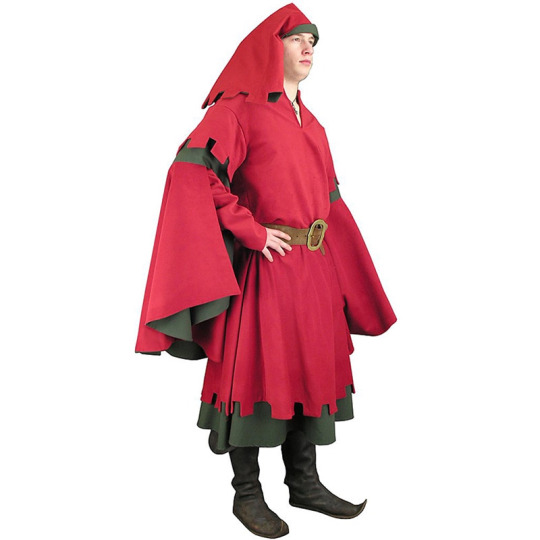
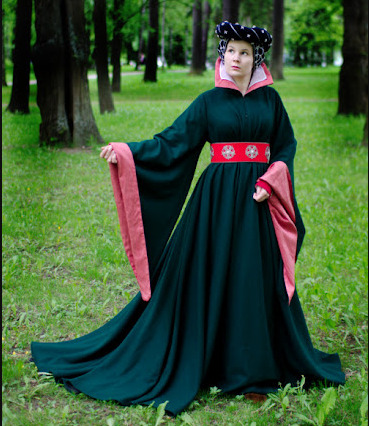

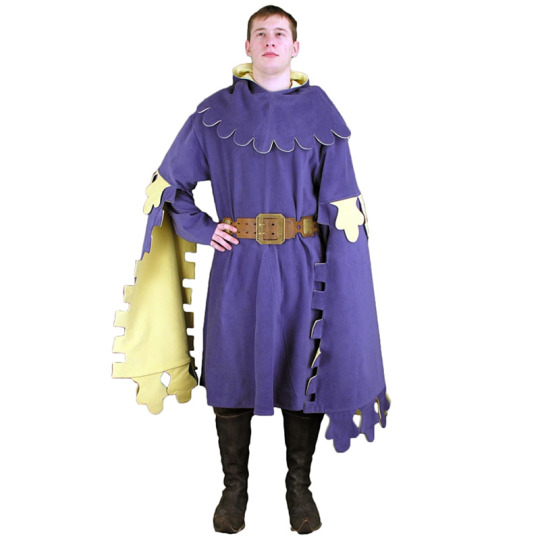

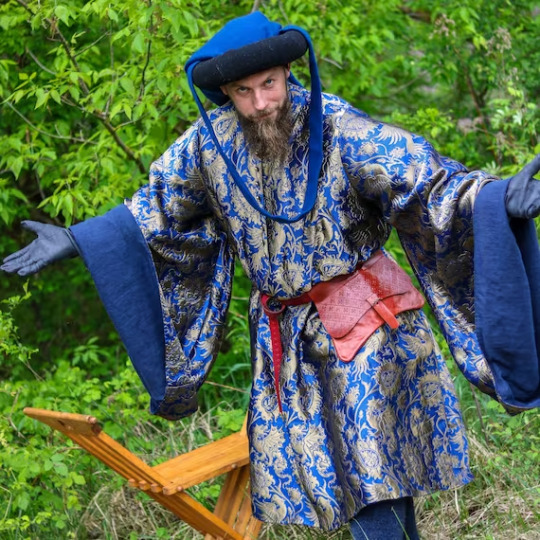
(As you can also see, early 15th-century fashion comes built-in with silly hats! Just like wizards)
In the 15th century you also have a wide array of cuts of cloaks (and even more silly hats!):
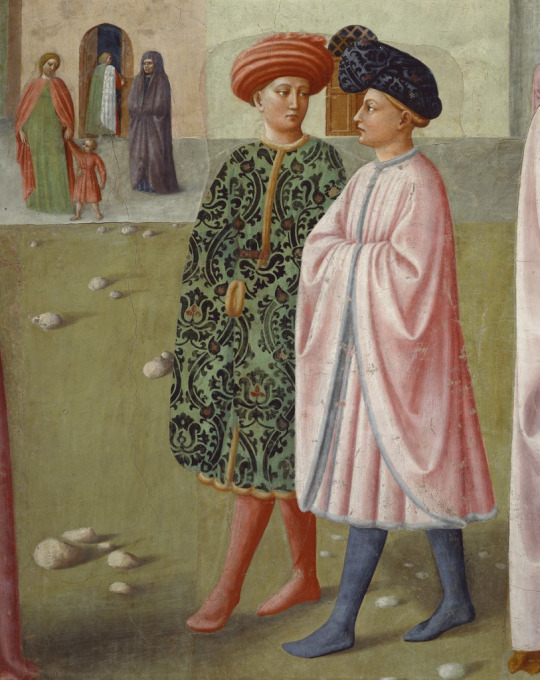
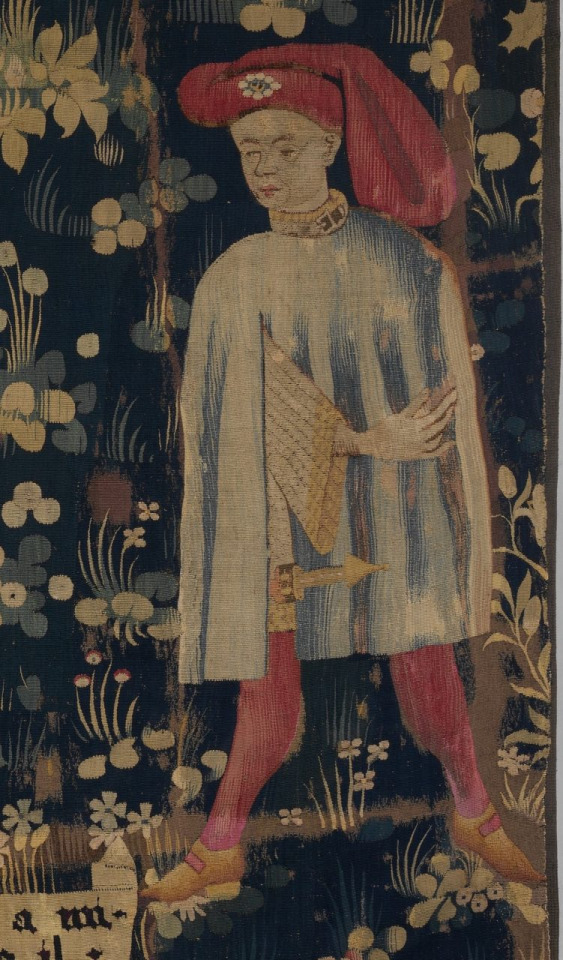
Along with surcoats, that contrary to their name, weren't just for knights to signify on their armor the house they serve:
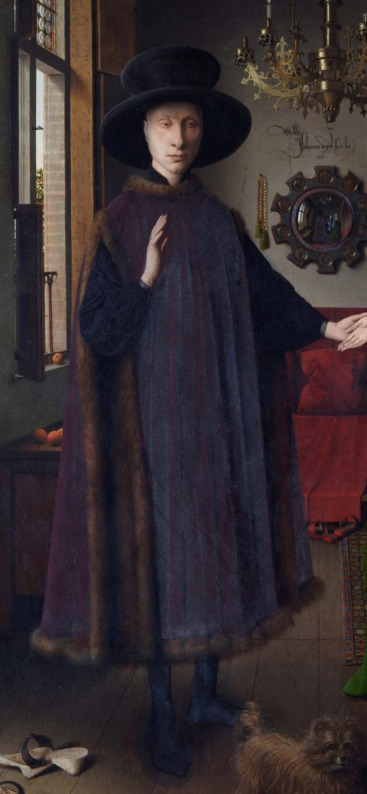
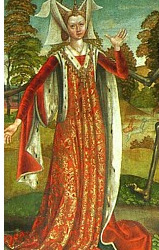
These 15th-century garments are exactly like wizard fashion is described in the books: billowing robes, colorful and eye-catching, and accompanied by silly hats.
The thing is, all these garments are from the high medieval period and as wizards broke away from muggles only when the Statute of Secrecy was enacted, I'd expect their fashion to follow the muggle trend up to that point and then start diverging. Even the most pure-blooded wizarding families of the modern day, like the Malfoys, integrated with muggle circles up until the Statue of Secrecy, something that would've forced them to dress like the muggles at the time to blend in better.
As the Status of Secrecy was first enacted in 1692, it's time to talk about:
Late 17th Century Fashion
Now, while the high middle ages in Europe had everyone wearing essentially wizard robes and silly hats on the regular, the Statue of Secrecy was enacted much later. Fashion in the 17th century was drastically different from the earlier one mentioned above.
In the late 17th century, this is the kind of dress I'd expect from women in England:
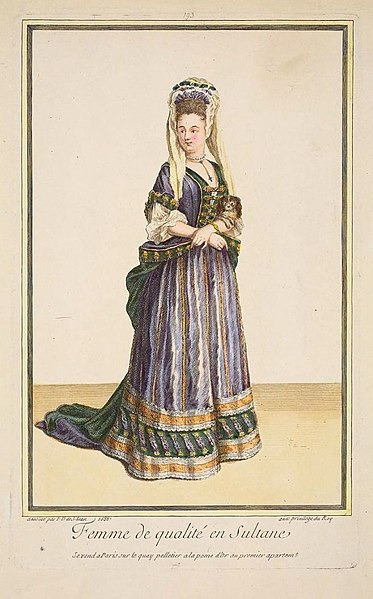
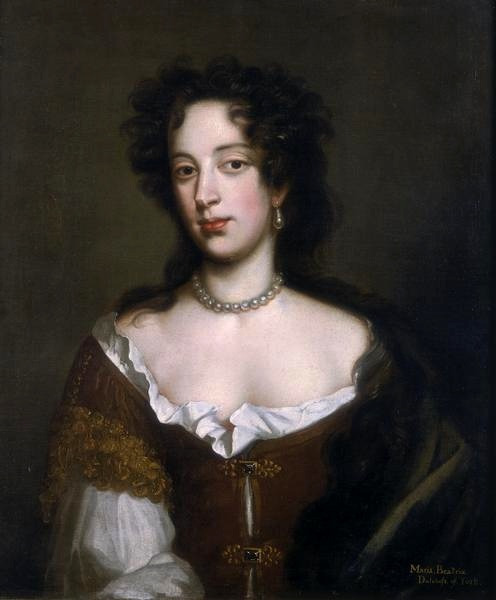
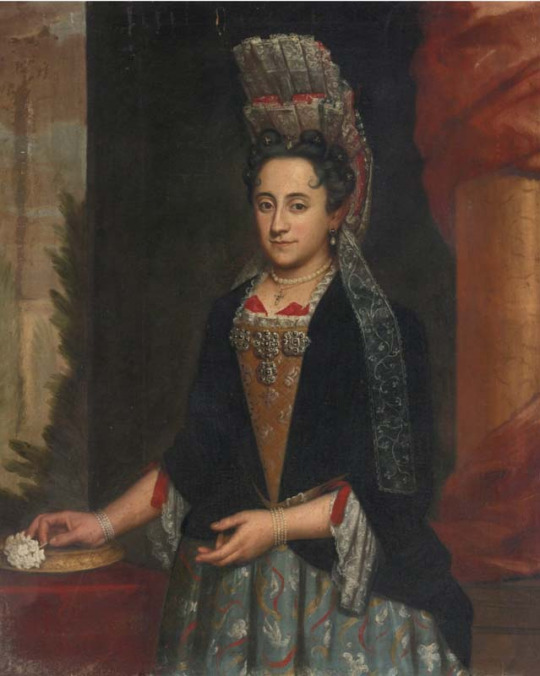

And this is what I'd expect from men:


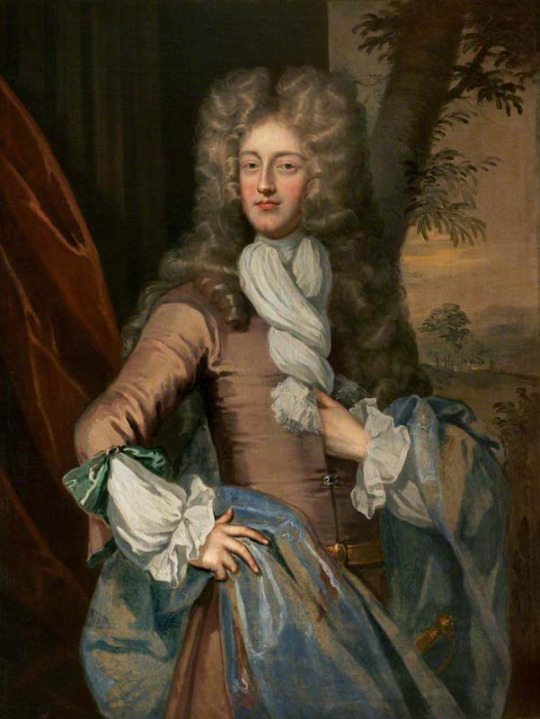
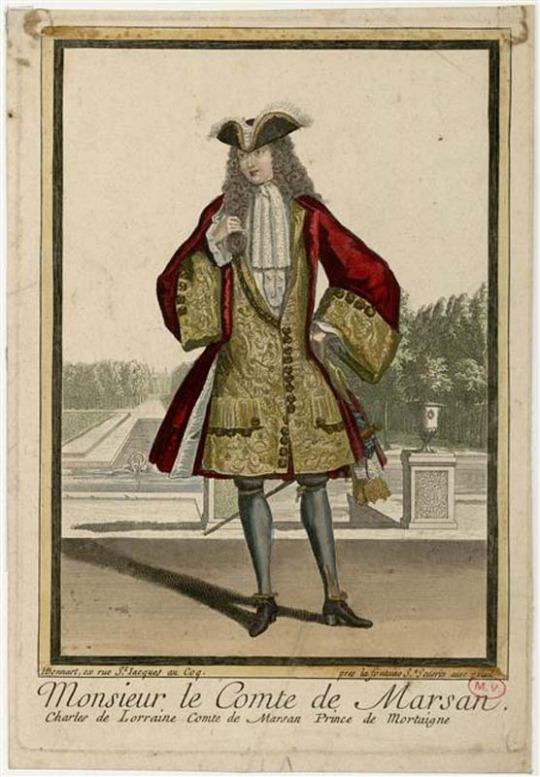
Which is very different from what is described but would've been the historical basis the wizards would work from.
So what do I think wizarding fashion is actually like?
Well, since the books are in the 1990s and wizards don't really live in a vacuum we know some later influences in fashion did make it in. So, I think wizarding fashion is an odd mix of 15th-century and late 17th-century fashions updated to the time period the wizard grew up in, hence distinct fashion changes between generations like we see in the muggle world.
We see these distinct generational fashion changes with characters like Agusta Longbottom who wears a Vulture hat. These sorts of hats with real birds on them were a thing historically. They were quite fashionable in the late Victorian era, which is when Agusta would've been a child if she's around Dumbledore's age:
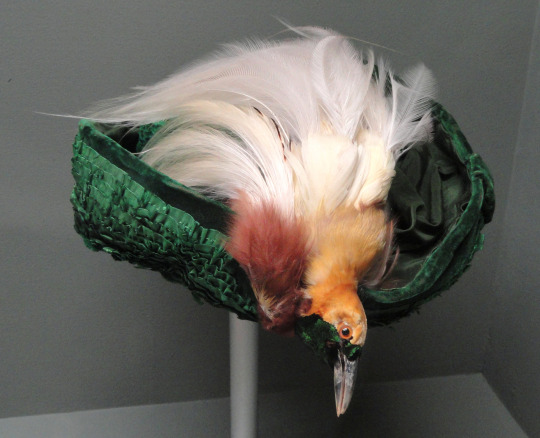

Fudge is described as wearing a Bowler Hat, a kind of hat that started catching on in the late 19th century but was still a staple in menswear into the early 20th century, hence indicating Fudge's age.
Ron's yule ball dress robes are described as old-fashioned, again indicating fashions in the wizarding world change at a similar rate to the muggle one. Note that since the 17th century, fashion has been changing quite rapidly and by the 18th century fast fashion where you need to buy new garments each "season" has already started becoming a thing. With all that, I think wizard fashion indeed changes just as rapidly as the muggle one.
Now, that's great, and all, but, what would that odd mish-mash fashion even look like?
Well, I made a few very quick sketches as concept examples for what casual wizarding fashion in the UK might look like if we're working off historical references:
(not my best pieces, it's just to get the concept across)

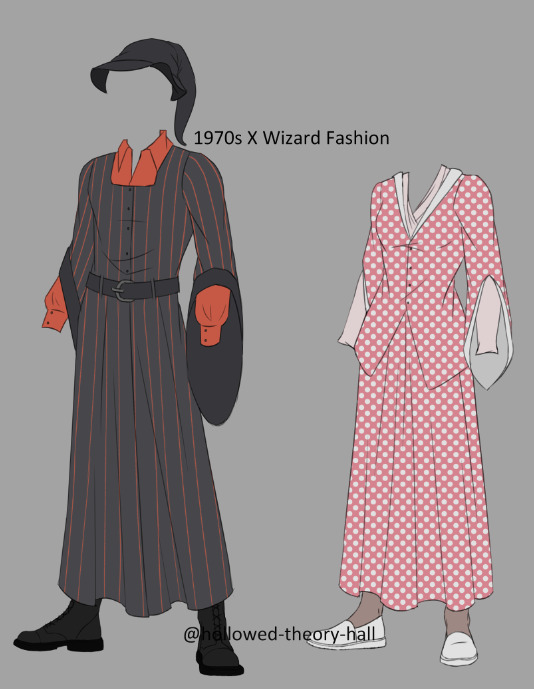

Note that Wizengamot robes and other formal professional wear would probably be older in style and closer to 17th-century fashions.
#harry potter#hp#harry potter thoughts#wizarding world#hp meta#hp headcanon#wizarding fashion#wizarding society#harry potter meta#harry potter headcanon#hollowedtheory#hollowedheadcanon#hollowedart#hollowed hp redesign
342 notes
·
View notes
Note
hello! i was wondering if you (or any blogs you think might know?) had any resources for edwardian fashion, more precisely edwardian teen fashion? i'm writing a story centering on two edwardian ghosts and would like help on their style of speech as well if you can't help on the fashion aspects. thank you!
In my opinion, if you want to be able to portray the authentic feel of a time period, there is nothing better than diving head first into primary sources.
Whenever I start any large research/writing project that’s centered on a particular year, I usually spend at least a couple of days just immersing myself in the era.
We live in an extraordinary age when it comes to primary source research (especially for the early 20th century) - there are literally millions of period newspapers/books/magazines/films/recordings floating around online.
Find out what books were popular and check them out! Read the newspaper! Listen to popular music! Watch silent movies or newsreels!
For teenagers, school yearbooks are a particularly great source to get an idea of how young people spoke, their senses of humor, common slang, casual fashion, as well as the daily routines and general vibes of the time period. Most universities have their yearbooks digitized and available online and can be pretty easily found on google (try searching: [year] [location if desired] yearbook digital collections).
As for fashion - there are so many great fashion history tumblrs, that it’s pretty hard to go wrong if you just explore the “Edwardian” or “1900s” tag a bit. One thing to keep in mind though - most dresses that end up in museums were owned by very, very rich individuals. So, though a great place to start, scrolling through blogs full of museum pieces to learn about fashion history is roughly the equivalent of learning about modern fashion by only watching Chanel runway shows.
By the Edwardian era most young people were wearing pretty much the same thing as adults by the age of 14/15. You were, however, starting to see the very beginning of what would become the modern “juniors’ section” - usually termed “Misses’” for girls and “young men’s” or “collegiate” for boys. Here are a few examples of this can be seen in period catalogs from 1912, 1911 (starting on page 21) and 1908.
It’s also important to keep in mind that fashion changed much, much more quickly than it does now. A woman in 1906 and a woman in 1911 would have noticeably different styles and silhouettes. I'd recommend scrolling through some fashion plates (going to shout out chic-a-gigot here who has a great collection of French fashion plates organized by decade and year) to get a basic handle on how the silhouette changed year by year.
In my past life I was fashion history specialist for high-end auctions, so I could go on in A LOT more detail about this subject, but I'm going to end it here before this gets too long.
159 notes
·
View notes
Text
Ace In The Hole: Discussing Asexual Representation In Hazbin Hotel And The Fandom
Alastor has become one of the most well-known asexual icons in modern media and has been the subject of quite a lot of discussion and discourse amongst fans, and I think there is a lot about this topic that really needs to be said. So, as an aroace, I would like to express some thoughts on how his asexuality is represented in Hazbin Hotel (with some mention of Helluva Boss briefly at the end).
To start with, scenes in the show that address the topic not only explicitly confirm that Alastor is cannonically asexual, but they also heavily imply that he is aromantic as well, and is more specifically on the averse side of those spectrums. To explain my reasoning, I will start with the pivotal scene, since this provides the most explicit information.


It is a very brief 10-second exchange, but there is actually a lot to unpack in just these two lines of dialogue.
Rosie teases him about being asexual by jokingly dismissing the idea of Alastor and Charlie being in a relationship because Charlie would be too young for him, and then giving a more serious reason in Alastor being an "ace in the hole". As Rosie is using this as a reason for why she knows Alastor wouldn't be in a relationship with Charlie, this is definitely a pun made in reference to his sexuality rather than the common use of the phrase, which wouldn't be a logical explanation. The pun, of course, goes right over his head as asexuality wasn't really known in the early 20th century when he was alive and Alastor doesn't tend to keep with the times as a rule. With context, though, Rosie's comment about Charlie being too young for him wasn't just a reference to sex. She was talking about dating. About sex and romance as a package the way most people do when we talk about "being in a relationship."
She has confidently deduced that Alastor is asexual, even without any explicit communication about it from Alastor. It would be extremely unlikely she could have come to that conclusion and ruled out all other possibilities (not having found the right person yet, currently being more invested in other aspects of his life, high relationship standards etc) if Alastor had confused the matter for them both in having much of an interest in finding a partner of any kind throughout their history, even if it was just a result of ingrained societal expectations. If Alastor had been on the favourable end of even one of those spectrums, it's extremely unlikely he would have been able to articulate and express his experiences clearly enough for it to be distinguishable from allosexuality and alloromanticism without being educated on the subject, which he isn’t. Rosie has also clearly known him for a very long time, almost certainly decades, which would be enough time to call other possibilities into question. And if Rosie - a proclaimed expert on the subject and a close personal associate of Alastor's - hasn't seen him express much of an interest in the decades she's known him, then it is extremely unlikely that he has an interest in it or ever will.
This is combined with the fact that, while Alastor seems to generally prefer the company of women to men, he has never shown attraction towards anyone and has expressed only disinterest or revulsion on all three occasions the subject is directly brought up to him (though the tone-deaf commercial he made in episode 1 indicates he's willing to make an occasional joke about sex if he thinks the comedic payoff is worth it, which I think is a very nice touch). They don't mean much individually, but all together with the pivotal scene, they do create a bit of a consistent pattern.



There is meta evidence for this as well. Amir Talai and others have also stated he is aroace, and while that has since been retracted to say he has only canonically been confirmed asexual, Vivzie has also stated that she doesn't want to reveal Alastor's romantic orientation so everyone can have fun shipping whoever they want and that it ultimately isn't important in the show, which is telling in itself. Not only is Alastor's canon romantic orientation the only one not explicitly revealed, but what other romantic orientation could be considered problematic for shipping besides a complete lack of romantic attraction? If Alastor really was romantically inclined, there would be no issue with being open about it, and I am absolutely positive that Vivzie would have said so by now.
So no. Alastor is not attracted to anyone and is not going to get together with anyone in the show. The two main defences that I've seen - "aro/ace people can still date/have sex" and "it was never confirmed he was aromantic" - do not really hold water in this case.
Now as for the representation itself. He isn't defined by his asexuality, and the show never directly attributed his more unsavoury traits to it, though care does need to be taken about the "doesn't love anyone because he only loves himself" trope. I believe Vivzie has insinuated something like that at some point, which would certainly be questionable. I personally don't mind the show's one ace character being a villain in this case, given the setting though. Many characters in the show are portrayed negatively in Hell, regardless of their sexuality, and conversely it could even be considered infantilising to have the one asexual character also be one of the few good characters in the show. Again, the show hasn't really made that correlation.
He is too fully-developed and integral to the plot to be considered a token character. He defies being an emotionless robot/socially awkward nerd stereotype by instead being a passionate, flamboyant, charismatic man who, despite being a ruthless serial killer and a cannibal, still seems to be capable of feeling affection for others and forming close friendships. It is actually refreshing to see. Amir said it best when he said "you don't have to fuck to be fab", and I think Alastor could be good villainous ace representation if...
1. His asexuality and aromanticism is aknowledged just a little more in the show itself so there is no room for ambiguity. So far the only confirmation we've had is a quick and subtle joke which, while appreciated, could easily go over the heads of people who don't know what asexuality is, just as it did for Alastor. Vivzie might be fond of dropping lore on livestreams and social media, but not everyone is going to know what is said by creators outside of the show, nor should they be expected to in order to judge Hazbin Hotel as a show for its own merits.
2. He continues to have a capacity for affection and friendship, and more negative traits such as narcissism and a lack of empathy aren't attributed to him being aroace. I think this is both important for giving him depth as a character and essential for avoiding harmful stereotypes. The idea that relationship averse aroaces aren't as capable of having profoundly loving relationships and will end up alone, and that people are boring or incomplete without a sexual or romantic partner is already a tired and insulting cliché that reinforces allonormativity/amatonormativity and it really needs to go.
Does that mean it is wrong to ship him? Well, not necessarily, though just because Vivzie said we could ship anyone doesn't automatically make it right. Personally, I don't like shipping in general, and I dislike Alastor ships on the basis of him being aroace, the fact that I think pretty much all of his relationships as portrayed in the show would be problematic as a romance regardless of his orientation, and my general preference for canon compliance when it comes to fan content. However, I recognise that is my personal preference and can tolerate a certain amount of it in moderation. It isn't necessarily wrong to ship Alastor - and I am certainly never going to begrudge a fellow aro/ace exploring their identity on the spectrum using cartoons as an outlet with the rare piece of rep we have to share when reps currently have the whole spectrum on their shoulders - as long as distinctions are made between fanon and canon, and that what has been established in canon is given respect.
Sadly, this hasn't always been the case and I can feel very uncomfortable with just how much he has been shipped and sexualised by some fans, and in a way that is blatantly disrespectful and out of character. After all, while also not "wrong" exactly, it wouldn't be ideal to ship a gay character in a heterosexual relationship, especially if the excuse that they haven't been confirmed to be attracted to the opposite sex is used just to make homosexuality more palatable. That would mean changing an innate and immutable part of them to the extent that they would no longer be considered the same person, denying representation. Why is it any different here?
The way the creators have handled it has also been giving mixed messages (with merch for example), and unfortunately, Vivzie's refusal to stand by his romantic orientation to allow shipping hasn't helped the situation. I understand wanting to avoid the bullying and vitriol that can come with shipping wars and that there will be shipping and upset fans regardless of what the creators do, but that doesn't make it potentially less questionable or hurtful for aroace people who want good representation, which should be the bigger priority. Having asexual and aromantic people being represented by an icon who is being used as queerbait by the creators and erased to appease toxic fans and prioritise shipping would simply not be a good look, however unintentional or well-intentioned. Care has to be taken by everyone to avoid that. Yes, Alastor is a fictional character, but a person's attitude towards him can still potentially reflect their attitude towards real aroace people.
Remember, "aro/ace people can still date/have sex" is a reminder that asexuality and aromanticism are spectrums, not an excuse to justify erasure in disregarding a character's canon asexuality/aromanticism and projecting allosexuality/alloromanticism onto them. There is so little representation already. We don't need what little we have being taken away.
In that vain, I would appreciate it if Alastor's asexuality and aromanticism gets acknowledged a little more in the show. Use characters like Angel Dust and Rosie, who are more clued in to LGBTQ identities. Rosie could hint at her reasoning for suspecting Alastor is aroace or usher away some Cannibal Town admirers. We're probably not going to see Angel Dust hitting on Alastor again, but those are the only two scenes they've directly interacted with one another.
Perhaps the other two hellaverse aces from Helluva Boss could be somewhere else on the spectrum. Alastor is a sex repulsed aroace. Mammon could be sex favourable, considering he has no problem selling sex robots of his mascots. Octavia could be greysexual or demisexual, be more neutral about sex but could still want to find love at some point. Imagine the Goetia family trying to arrange a marriage for her. And what about more unusual dynamics, like one-sided ships or QPRs? Just some ideas, if only for fanfiction. They are both big spectrums. Let's have fun exploring them.
#no hate to anyone - shippers or otherwise - please be respectful#also am i the only one who thinks 'ace in the hole' is an adorable pun for a closeted ace?#or that 'you don't have to fuck to be fab' is something alastor might actually say?#vivienne medrano#vivziepop#hazbin hotel#hh alastor#hazbin hotel alastor#hazbin alastor#alastor the radio demon#asexuality#asexuality spectrum#aromantic#aromantic spectrum#aspec#asexual alastor#sex repulsed alastor#aromantic alastor#aroace alastor#asexual representation#aromantic representation#queerbaiting#erasure
42 notes
·
View notes
Note
Starting my period in the next 48 hours :( how would Dream handle a miserable menstruating partner?

Dream finds you in your bed, curled up around a pillow that's holding your heating pad to your abdomen. He's extremely alarmed to find you in such a state, but you seem to be begrudgingly resigned to your fate.
"Who has harmed you?" Dream asks, settling a hand on your shoulder. You look up at him hesitantly, waiting until you're sure that a bout of nausea won't attack you, and sigh.
"Nobody. I got my period this morning and it's kicking my ass."
He looks confused about what you mean, likely still used to the early 20th century terms like "monthly" or "cycle" (you're not really sure what they called periods back then, but you know that they weren't so blunt about it, and especially not around men). In a normal situation, you'd take the time to explain the modern verbiage to him, but you're not really in the mood today to harness the patience that such a task requires. He's the King of Dreams, you think, he can use his infinite knowledge to figure out what the fuck a period is.
Sure enough, you watch his form waver just slightly as he mentally escapes into his realm to figure out what you're talking about. After a moment, he fully returns to his corporeal form and nods with obvious sympathy in his eyes.
Good job, Dream.
"Are you in pain?" It seems like a question with an obvious answer, but he's trying, so you nod instead of snapping at him like you instinctually want to.
"It hurts so much," you lament. As if in response, your uterus cramps harshly, and you wince. "I think I'm gonna die."
Dream breathes out a laugh, making you glare at him. "I assure you that today is not the day my sister comes to give you her gift."
"Why won't you just let me complain?" you whine. Much to Dream's horror, your eyes fill with tears, and he begins to panic as he tries to figure out what he's supposed to do with his menstruating beloved.
"Would...complaining make you feel better?" he attempts to appease you, at this point prepared to do anything if it means that you stop looking at him with your pouty lip and wet eyes.
Your only response is to shrug.
"Then by all means, complain."
"No, now I feel bad. I shouldn't have been complaining." You're still pouting, but this time it's due to your own actions rather than his. "I'm sorry."
"You need not apologize." Gently so as not to cause you any unnecessary pain, he sits down on the edge of the bed next to you. "Is there anything that I might do to help you feel better?"
You think for a moment. "Would you read to me?"
It's a simple ask, but it's one that Dream is more than happy to comply with. He lifts his hand up and pulls a book, the one you've been reading with him in the Dreaming, out of thin air. Gingerly, you curl up next to him. It takes a bit for you to find a position that's comfortable for you, but when you finally find one, you allow Dream to rest his hand on your back as he flips open to the page you had last left off on.
When he's made it through two chapters, Dream looks down at you to see your eyes closed and your face free of any pain. Normally, he'd jump at the chance to follow you into his realm and spend more time with you there. Today, he's happy to let you nap in your own personal dreamscape for a couple of hours while he frantically searches his library for any information concerning how one cares for a menstruating loved one—a task that might just be more difficult than recovering his tools had been.
#chat with claire#the sandman#the sandman imagine#dream of the endless x reader#dream of the endless imagine#dream of the endless#morpheus x reader#morpheus imagine#morpheus
400 notes
·
View notes
Text
2023 Reading Log pt 7

31. Rare Trees by Sara Oldfield and Malin Rivers. OK, so apparently that whole “less books about plants” pledge didn’t take. In my defense, this book is really pretty. It’s also very good; it’s about efforts for tree conservation around the world, and is published both as a public report and a fundraiser for the Global Trees Campaign. If you want to know what boots on the ground conservation work is like, its successes and its challenges, this is an excellent resource. And, like I said, the photographs are very pretty. The first chapter is about the overall history of forest conservation, and then future chapters discuss trees categorized by uses and by phylogeny. Honestly, I kind of wish they had picked one or the other of those organization schemes instead of splitting the difference, but that’s a quibble.
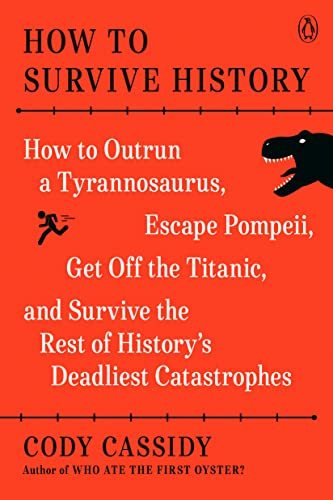
32. How To Survive History by Cody Cassidy. I’ve recommended some of Cassidy’s other books before (Who Ate the First Oyster? and …And Then You’re Dead), so I’m happy to report that this is his best yet. The theme is, what does science and the historical record tell us about how you could survive various catastrophes, or just hostile environments? I knew I was going to like it from the first chapter, How to Outrun a T. rex, which treats dinosaurs as just animals rather than kill crazy monsters. It also does an excellent job of summarizing Very Bad Times like the Donner Party expedition and the Magellan circumnavigation, and I learned a lot (like about how Magellan’s slave Enrique was the first person to actually circle the globe, having been captured by slavers in the Philippines and then being brought back around… and getting his revenge when he wasn’t freed as Magellan’s will proclaimed).
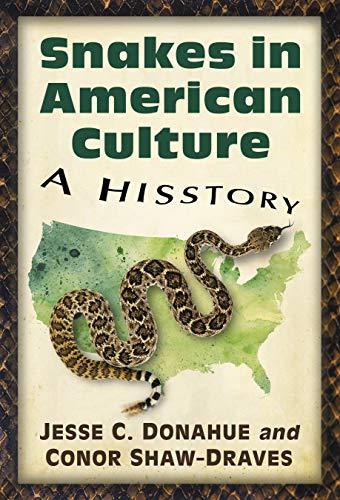
33. Snakes in American Culture: A Hisstory by Jesse C. Donahue and Conor Shaw-Draves. I didn’t expect this to be a searing indictment of the American medical profession of the early 20th century when I started the book, so that was a pleasant surprise. The first half or so is the story of how (white, upper class, male) “experts” denied that venomous snakes in the USA were really all that dangerous, while people (mostly poor, ethnic minorities and children) were dying in large numbers. Antivenin was only developed in this country as a side effect of the United Fruit Company’s desire to keep laborers from dying in the fields from snakebite, and the development of said antivenin was mostly done by volunteer labor and then marked up for tremendous profit by pharmaceutical companies! The back half, unfortunately, isn’t nearly as good, although it doesn’t go full conversion with its fairly sympathetic portrayal of snake handlers (which is something I’ve run into before). My biggest complaint is that this was written by humanities professors, and they needed a trained biologist to go over their draft. For example, they can’t format scientific names correctly, and don’t know enough about the history of science to understand that “virus” and “venom” were used interchangeably by some authors in the 19th century.
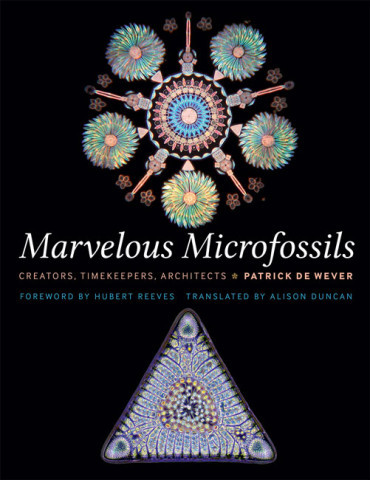
34. Marvelous Microfossils by Patrick De Wever, translated by Alison Duncan. Worst book I’ve finished this year? I think so. This book was originally written in French, but I can’t blame its problems on translation issues. It’s about plankton and other microfossils, what they can tell us about geology and how they’ve influenced art and culture. To start with the good, the book is gorgeous; each page is well organized, and it has lots of electron micrographs, photos and engravings by Ernst Haeckel. And that’s the first problem. The author seems to be a modern devotee of Haeckel’s science and philosophy, when both were full of garbage (Haeckel is the “ontogeny recapitulated phylogeny” guy, and one of the codifiers of scientific racism). His use of terminology is stuck firmly in the 19th century, and he doesn’t seem to care about modern cladistic phylogeny at all. And he has lengthy quotes from architects and philosophers instead of, you know, modern scientists, including lines specifically about how “we understand all there is to know” about plankton from like 1910. So I get huge “reject modernity, embrace tradition” vibes from this author, and that makes my skin crawl.
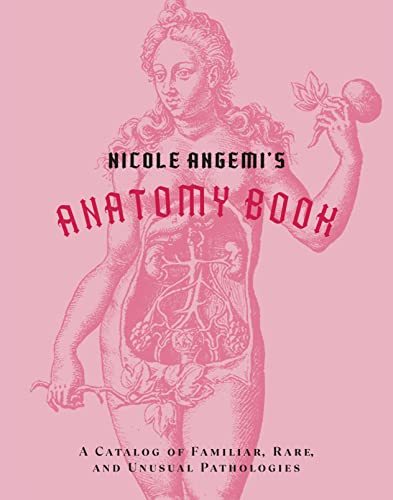
35. Nicole Angemi’s Anatomy Book by Nicole Angemi. Another “searing indictment of the American medical system”, only this one is more modern. The book is a loosely A-Z collection of pathologies, with case histories and photos. So this one is super gross, just a head’s up. Why I say it’s a searing indictment is that about 1/3 of the case studies talk about how the patient was ignored by their doctors initially, and had to spend time seeking second opinions taking them seriously, and how a number of things that could have been fixed more easily turned into huge, life altering (or ending) problems. The book is written by a pathologist’s assistant, and the introduction/biography would make a good “see, you can follow your dreams and get a career that you love later in life” inspirational story. I’m keeping a copy of this for my classroom, because I have plenty of students who are interested in medicine but not necessarily medical school, and because teenagers love gross pictures. Seriously, some of the descriptions of cysts and tumors made even my stomach turn.
#reading log#anatomy#medical history#snakes#herpetology#paleontology#plankton#botany#ecology#conservation#trees#world history
76 notes
·
View notes
Text
"I do think that the selection of Walz is kind of - to me it feels like a watershed moment. It does feel like a generational shift. And by that I mean the generation of the kinds of the politics that the Democratic party is starting to practice now is a real departure from what has been practiced in years past. Sometimes one of the things that I have to communicate when I'm on the inside, when I'm talking to other elected officials or other people in the party is a generational shift doesn't just mean that you're electing younger people. Like there's a reason why young people were so supportive of Senator Sanders in 2020, why he had the most amount of youth support when there were a lot of - plenty of candidates that were younger than him. There's a reason why young people elected and supported Senator Ed Marky in Massachusetts over younger candidates and options. Because I think and something that i've heard from a lot of other elected officials before is that young voters are far more substantive than I think elected officials are used to us being in the past. It's - you know, I think a lot elected officials have dealt with this, I don't know if it was a stereotype or their experience of young people being apathetic or uninvolved. And if anything right now, I feel like when - sometimes when people don't vote, it's not because they're uninformed. It's actually cause they're very informed, and maybe they don't like their options or maybe they're unhappy with something. But they are very keyed in and informed about what's going on. And now what I'm also sensing is like there is an enormous substance to the youth vote. They want to know about what's happening to end the war in Ghaza. They want to know about what policy commitments we're going to make to stop the climate crisis. They want to know what we're going to do to guarantee health care to every American. They want to know what we're going to do about the skyrocketing costs of college education and student debt. And - you know. That includes tons of other issues, as well. So I'm really excited, because at least part of what I've experienced is that - and what I've also said the last time I went live - is that one of the concerns that I've really had is the influence of this kind of professional, consultant class that is not as rooted in community and in brass tacks organizing as I think, you know, a party should be. And I think what we are seeing, slowly but surely, is a return to the Democratic party's actual roots - of a populist working class party that we saw and by the way had huge majorities and were able to sustain huge majorities in the 20th century, in the early and mid 20th century. I am looking forward to a Democratic party that is moving past the kind of 90's era triangulation politics and getting back to our roots of being FDR Democrats, of being populist working class democrats, labor Democrats with the added integration of a modern intersectional lens that is aware of racial rights, that is aware of women's rights, that's aware of and fights for Civil and LGBT rights and integrates the material identity values. Not just superficial - we're not talking about tokenism, we're not talking about just pure representation politics. I think people are just so much more aware that this is so much more about being the first but it's about embodying what a first means, which means fighting for the people and places that we come from. And I think Tim Walz does that. And I think that Kamala Harris does that. - AOC link to Youtube video
11 notes
·
View notes
Note
I WANT TO KNOW MOREE ABOUT STICK FIGURESSS. I AM SERUOUS
The stick figure first came into use when early man thought it'd be a fun idea to record what they'd done on walls, like a tumblrina textposting. But because early man had only just worked out what drawing was, they were quite shit at it. This meant all they could really draw was stick figures, hence their popularity in the caveman art world.
however, when humans realised they could use surfaces other than cave walls -- such as walls they built themselves -- they also realised they could make things that looked more like a human than an awkward weevil, and so they started making their stick figures a little realistic and gave them faces and actual substantial arms. Some societies even went so far as to use the evolved stick men as writing!
things only continued to get worse for the stick figure when humanity worked out they could do more than just DRAW on cave walls, they could carve them! Working out things existed in 3 dimensions led to the realisation that body parts really weren't that skinny so stick figures fell further out of use. The Romans were a big fan of wall painting (or 'graffiti') which you think would've helped the stickmen, but the Romans really liked drawing penises on walls and not much else, which is why Pompeii looks like a South London public toilet.
After the Romans came the dark ages, where every continent except Europe was doing great and still making their non-stick figure art. Europe was probably also not doing that, but I don't know or care.
Europe picked up its act after about a millennium of pissing about, which led to the Renaissance -- or 'rebirth' if you're like my brother and speaking French makes you want to vomit. From here on, the stick figure was in the shitter. People were actually trying with art now, which meant they were making things "realistic", a term nobody had ever used to describe a stickman.
By the early 20th century, all seemed permanently lost for stickmen. All the art movements after the Renaissance had continued going for realism and ugly babies, which basically meant no stick figures. It didn't seem like they were coming back.
But if you thought that then, you'd be a big dumb baby. Artists who were really good started being bad on purpose to make life a bit easier and to get people to use their brains. This led to the invention of Modern Art, which was like old art but new and people complained about it more. Stick figures were loved again!
Graphic design took a tip from modern art and made things simpler too. Suddenly stick figures weren't in the shitter -- they were on shitter doors, telling you what gender belonged in what bathroom! Nowadays, you see stick figures on signs everywhere, telling you what to do, like no pissing in public or telling you you can be gay or something. Crazy how far they've come.
#long post#thanks for the ask!#look im bored and on a train back to shitheap england this is the best ive got in terms of enrichment#stick figure history
86 notes
·
View notes
Note
Please innumerate for us the specialized problems of the library sciences.
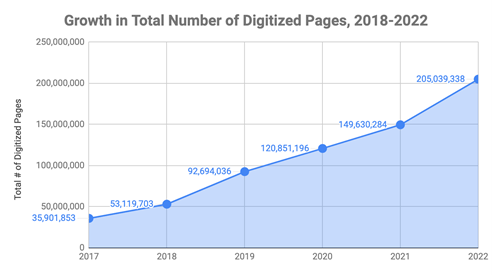
Let me start with the caveat that my information is based on my experiences at the National Archives more than a decade ago, and policy has definitely changed on this front as we can see from this graph of recent digitization - apparently NARA wants to get to 85% digitization by 2026. (Even still, I'd note that the records of the WPA are <0.001% digitized.)
However, back when I was doing the research that would eventually become my first book, I remember being at the National Archives II building in College Park, Maryland (Go Terps!) and getting really frustrated that all the records of the WPA were only available in their original physical form and that all the guides and indexes were also in paper only and were all from the 1970s, and I asked the archivist why the hell the National Archives hadn't been digitized already.
This is what they told me: if it's handled correctly and stored in the right environmental circumstances, paper can last a thousand years. Carbon copies can last even longer, if they don't rip. (Seriously, the bastard things are like onion skins, they'll split if you look at them funny.) Microfilm is slightly more technologically advanced than paper, but it only lasts 500 years in the right conditions.
We've only had computers en masse since the 1980s, and already there's a huge amount of records (especially from the early years) that we don't have any more, because the hard drives got re-formatted due to higher costs of storage space back in the day, or because old computers got thrown out when they were replaced by newer models and the hard drives are all rotting in landfills somewhere, or because backwards compatibility broke down and we just can't read those file types on our modern computers, or because the actual data got corrupted on the disc, or because some legacy company is asserting copyright against a video game museum, or because some political hack and/or president of the United States decided to violate the Presidential Records Act.
While we thought that the internet would cause an explosion of written records from ordinary people on the scale of the advent of mass literacy, there are vast swathes of the early internet that simply do not exist any more because the servers got switched off when Geocities et al. folded in the dot-com bubble burst or when everyone migrated to Web 2.0, and the Internet Archive tries its best (bless its heart, affectionately) but it can't be everywhere and save everything.
As a result, the archivist told me, digitization is a fraught question: what file format do we use? How do we know that file format will still be compatible and backwards-compatible in 50 years? 100? Longer? Do we keep everything locally or store it on the cloud, and how do we ensure that the storage mechanisms won't fail if there's a blackout or a virus or whatever? Do we digitize everything now, or do we wait until optical character recognition improves enough to the point where digitized records can be searched for words and phrases? Etc.
Keep in mind, I am a public policy historian who studies the 20th century U.S - I work primarily with the official records and the central archives of the richest government in the world. From a library sciences perspectives, this is kind of an ideal scenario, and it's still kind of fucked up. (Let me tell you, the rage and grief I felt when I learned that most of the General File of the Public Works Administration was thrown away by the National fucking Archives and Records Administration in the mid-1950s because they were running out of shelf space in the D.C location and didn't think these records were important...)

Now imagine what it's like at a local historical society or a small liberal arts college, or the national museum of a developing nation for that matter, who do not have the resources for the kind of grand digitization project that NARA started doing five years ago. Think of the sheer scale of historical records that sleep, unseen and untouched perhaps for decades and perhaps for ever, in little cubbyholes all across the world. Among professionals, historical records are measured in linear and cubic feet - think about that for a second, how many pages of paper there are in a foot when you stack them up, and how many hundreds and thousands and millions of feet there are across the face of the world. Think of all the millions of feet of pieces of paper that have been lost to us because of fire or rot or war or time itself.
This is why Peter Turchin is a quack. Historical records are not a standardized little database for social scientists to plug their fucking spreadsheets into; historians don't play that kind of bullshit t-ball, with all our data neatly packaged and handed to us on a silver platter. Our profession is not a social science, it's a goddamn treasure hunt through boxes that were never catalogued or categorized (or that were re-catalogued so many times no one remembers how they were put together in the first place) to find writing that no one has read since the authors died. All of us know that our work, our understanding, will always be partial and limited, because memory is infinitely fragile and the very idea of historical preservation is a mad existential defiance of entropy itself. These records are real, they are fragile - to hell with the Library of Alexandria, remember the National Museum of Brazil? - and they are all that is left to us of the dead.
108 notes
·
View notes
Note
hello! i am a longtime huge admirer of your clothing/fashion sense, as well as a longtime backreader of your #victorian and #goth tags. i am really interested in what you've written about Victorian dress, and i am looking to get more into 19th and 20th century clothing for gender + diy craft reasons. i'm so sorry if you've answered similar questions before, but do you have any tips for where a newbie should start researching? either way, thank you thank you, your blog opens my mind wide and brings me much joy and reflection!
General research:
Spend some time searching the 'net, museum websites, and archive sites for fashion plates (such as archive.org—link leads to a date-restricted query for "fashion"—or the Smithsonian—link leads to fashion plates in their image collection). Take note of what you like, as well as which styles correspond to which decade. Karolina Żebrowska has a good rundown of English fashion over the decades.
The undergarments are what does the most work creating the necessary silhouette to make Victorian & Edwardian womenswear fit properly. If you've figured out a decade you want your outfit to draw on, doing a quick search for "[decade] undergarments" should bring up plenty of blog posts, which may or may not cite primary sources (such is the fickle nature of the historical blogosphere). Bustle pads and sleeve supports can be purchased or made; they're both pretty simple, and tutorials abound.
Purchasing clothing:
Reproduction made-to-measure clothing can be readily found on etsy, but can be in the several-hundred USD range. I've had some luck finding vintage reproduction clothing (like, a skirt someone made by hand in the 1980s to a 1900s walking skirt pattern), which tends to be much cheaper.
Men, women, and children wore stays and corsets. As far as I know, Orchard Corset has the cheapest OTR corsets that are good quality and safe to wear. If you get a corset in the style of a specific decade handmade or made to measure, make sure that the seller tells you what the boning material is, what construction the boning is (spiral steel is sturdiest and most flexible), how many bones there are, what the corset material is, &c.—otherwise it's an indication of an unserious maker. Follow general advice for wearing corsets at a waist reduction (lace up slowly, break it in, &c.).
Antique Menswear on youtube gives a lot of good, practical advice for wearing late 19th-century and early 20th-century men's clothing (including where to buy reproductions and how to treat them, how to modify modern shirts to 19th-century standards with basically no sewing skills, &c.).
Actual antique clothing can be found and purchased online or at estate sales—usually in very small sizes, but I've seen Edwardian skirts and petticoats in an XL (also a small size, but...). You can also just simply browse this kind of thing for inspiration and save photos of anything you think you'd like to recreate.
Even clothing that was not "meant" to be worn by re-enactors can be clearly historically influenced (e.g. the huge boom in Victorian- and Edwardian- style blouses in the 1980s), so keep an open mind when shopping for vintage clothing! A lot of 1970s dresses that look "hippy" on their own can look very Victorian with the right undergarments and an updo. A lot of 1980s men's trousers also approach the right silhouette for the 1910s-inspired three-piece suit I'm trying to put together. Witness also the recent trend for big puffed sleeves!
Making or modifying clothing:
Victorian and Edwardian manuals for garment drafting and sewing can be found online—go to archive.org and search for "sewing," "drafting," or "dressmaking," then use the filters on the left to chuse which year(s) you want to see results from. Most of these have patterns that are sort of vibes-based: The work-woman's guide is one manual that claims to have patterns laid out strictly according to a grid.
I don't sew garments, but if Victorian pattern-writing for sewing is anything like it is for knitting, that may not be super useful. People do sell updates and graded 'translations' of antique patterns (which tend to be written in only one size) on etsy and ebay—just make sure from the description that it's 'deciphered' and translated rather than a scan of the original pattern!
One of the easiest things that you can do to add some Victorian or Goth flair to an otherwise plain-looking garment is to add trim. You can knit, crochet, or tat your own trim from Victorian lace-making patterns; purchase antique trim from resale sites; or buy braided or lace trim very cheaply at any craft store. Trim doesn't just have to go around the hems and cuffs of a garment: lace "insertions" between two pieces of fabric, as well as raised geometric patterns over the surface of a garment, are common in 19th-century clothing.

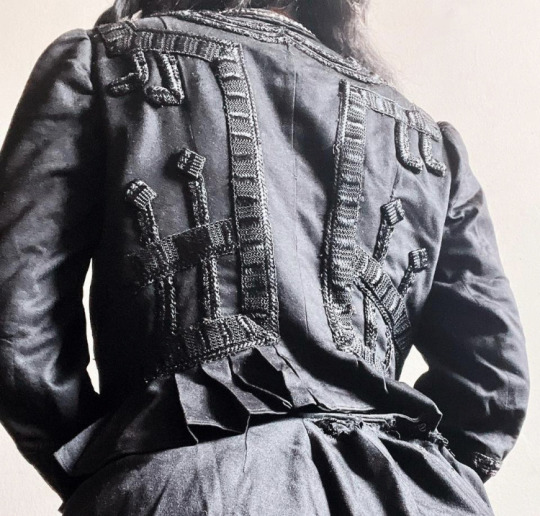
[ID: first image shows a black overdress showing lace insertions between strips of fabric of equal width, creating a striped effect. second image is the back of a black blouse with trim in a geometric design centred around right angles and parallel lines. end ID]
Jewellery (women's and men's):
Actual antique jewellery (including men's jewellery and fastenings) is not as expensive as you might think. Even if you're not willing to spend a lot of time learning what to look for and scouring estate sales for people who don't know or care what they have, late Victorian mass-manufactured costume jewellery often goes for sub-$50 or even $30 prices at auction on ebay (USD, in the US—in my experience it is even more plentiful and cheaper in the UK).
Specifically, I've lucked out with lots ("lot" as in, a bunch of small things being sold together) of "vintage men's accessories" going for $20 or so that contained Victorian cufflinks (in low-karat gold, mother-of-pearl, and jet), collar studs (in low-karat gold and base metals), and shirt studs (in low-karat gold, with garnets and seed pearls, &c.). Searching for lots of accessories is generally a good idea since by and large people do not know what these things are... but if you're willing to spend a little more for something that has been identified and is more likely to still be with its set, use the specific search term for that item (e.g. "antique collar studs").
Answers to Questions About Old Jewelry (though aimed at estate sellers and, if memory serves, full of regrettable pæans to Queen Victoria) is a good reference text to dating antique jewellery. I also recommend Miller's Illustrated Guide to Jewelry Appraising. Both of these texts are available on libgen.
Feel free to ask me follow-up questions if you want more detail on any of these points. As you can see I am perfectly happy to blather away on this topic
85 notes
·
View notes
Note
I needed to ask this because i couldnt sleep
is Norm conservative?
because on one side it would make sense due to his patriotism and his age. But on the other hand if he was i think he would have acted way diffrent and atleast after the thirdchapter it seems out of place.
So please answer the question so i can sleep
The detailed answer to this question is very long, so I'll put it behind a 'read more' line so this doesn't clog up anyone's timeline.
The shorter answer to this question is: Norm's political beliefs cannot be summarized using any single commonly understood word from our 21st century vocabularies because his stances, alongside what Norm considers political/apolitical topics, don't align entirely with 21st century definitions/standards as Norm is a time traveler from the mid 20th century.
He isn’t a 21st century conservative as much as perhaps an early 20th century one, with a few stances that were considered progressive/radical for that time. Many aspects of the character that we’d consider conservative weren’t in his time, and were only regularly politicized by one side of the political aisle years after he warped. If you want a longer answer where I point out where exactly this blurs the line, read more:
The problem with this question (and most political discussions) in general is that most people don't read up on political history for fun and so, they naturally associate words like 'conservative', 'liberal', 'socialist' with the rhetoric/stances of whoever is currently using those labels in their society. Most people reading this would look at, for instance, the modern Republican party in America and say "oh, that's a Conservative."
Now, here's the problem: Norm grew up largely in the 1930′s and warped in the 1960's, society as a whole was radically different. One big difference is, for example, religion. Norm believes in God, and this is something that’s considered old-fashioned by many. It's pretty unfashionable to be religious nowadays in many places, but in most of 20th century America, it was a far bigger deal not to be. Nowadays, religion is something that's associated with the right more than the left, but in the early to mid 20th century, both parties were extremely religious.
Democratic political machines were dominated by Catholics in the early 20th century. Democratic presidential candidates Al Smith and JFK (the latter of whom was elected in the decade Norm came from) were Catholics, and it actually mattered to many voters. William Jennings Bryan (3 times Democratic nominee) was also immensely religious. Even the far-left fringe elements of the party had religious thought leaders, with Father Coughlin (a priest with a radio show) influencing far-left 30's Democrats. I could go on. Republican party also produced quite a few deeply religious presidents, with Garfield and Eisenhower coming to mind. A large portion of the population was deeply religious for most of the nation’s history, after all, and the religious beliefs of candidates mattered far more than today. So, for his time, Norm's religion is something that wasn't politically partisan, but rather, broadly essential, and as such, Norm would find it strange that anyone would assume that his religious beliefs correlate with his political beliefs at all.
Economically, America has changed so much in the 20th century that the issues at the start of the century are unrecognizable to us now. In 1900, the core economic issues were whether to back the dollar with just gold, or with gold and silver... oh, and the tariff. Exciting. No welfare net existed because income taxes largely didn't exist. The Federal Reserve didn't even exist yet! Tariffs (taxes on foreign goods) were the main source of federal income. What we consider to be normal governmental function was considered radical by many back then.
Similarly, it's important to note that the modern welfare state as we know it today was created in the 1940's with the advent of Social Security (AKA, in Norm’s lifetime) and only expanded to something resembling what we have today very incrementally, with many large developments happening under president Johnson in the mid 1960's... After Norm jumped.
Gun control (especially in sparsely populated states like Arizona) was basically a non-topic, and the only major federal gun control legislation that I know of being passed in the first half of the 20th century was a 30's crime bill that outlawed heavy machine guns + sawed offs, specifically related to organized crime tied to prohibition era organized crime. Norm loves guns, but he’d be profoundly disturbed to learn about how many mass shootings America has had in the last 20 years and wouldn’t just be able to hand-wave it away as normal, as our society has... because outside of the fucked up racist mass shootings of the 20′s (like Tulsa, but there were many also more smaller ones the same decade too), mass shooting weren’t a constant occurrence! NUTS, RIGHT??
Next, there’s Norm's patriotism, which your question implied pointed towards him being a conservative, but like his religion, this is an apolitical trait from Norm's time. Norm lived through World War II and the Red Scare, times when patriotism wasn't just popular, hell, not acting like Donald Duck in a 40's WWII propaganda cartoon meant you could go to PRISON. Media was also heavily controlled by governmental/anti-communist entities at this time, with the government financing pro-American/anti-communist films in the 50′s and Ronald Reagan serving as leader of the Actor’s Guild. Communists were rooted out systematically and to Norm, keeping a loaded firearm next to your bed in case a ‘communist’ breaks into your home is entirely normal and he refuses to cut it out. Poor guy’s scared shitless.
Norm does have a distaste for 'big government' and wasteful spending, partially explained by the time he came from, where taking taxes for public spending was still considered a more radical idea, but also, Norm's extras sheet gives even more essential context to this mentality with the explanation that he was raised in the middle of bumfuck nowhere by a single mother. Growing up, self-reliance was a necessity, not a virtue. His attitude towards governments basically amounts to "Leave me the FUCK alone." He values resilience, charity and discipline because these values are what enabled him to survive growing up.
Norm also grew up in the wilderness, so he enjoyed a lot of freedom growing up that is arguably impossible in urban areas, in his own time and especially today. Most of his stances come from the belief that the common person is inherently good (a belief that he temporarily abandoned after the warp, and Gingi managed to restore), and that political power structures solely exist so those who are already rich can stuff their pockets at the expense of taxpayers. Norm considered both of the two parties of his time to be corrupt and self-serving, and would say the same of them today, which is why Callum Crown’s third party populist rhetoric, and returning control of the US economy to working class people really resonated with Norm.
When asking why someone like Norm would support Crown’s movement, it’s important to note that Callum softened his socialist rhetoric as a national candidate. Norm also didn’t know all of Callum’s stances/beliefs (and realistically lied to himself slightly about some of them.) Norm also missed the end of Crown’s presidency, having to educate himself with revisionist sources after the warp. But, it would be dishonest not to mention in a complete answer to this question that Norm supported the single least conservative candidate in US history (in DT’s universe) for president because he felt it was the right thing to do.
Norm’s beliefs largely boil down to believing that individuals know best how to live their own lives and that as long as you aren’t hurting yourself or others, it’s none of his business. It’s his core tenet, really. He gets very modest when intimate subjects are brought up around him and the last thing he wants is to know what anyone does in the bedroom. Norm isn’t a homophobe or against gay marriage because... well, why would he be? There’s plenty of modern behaviour that is prohibited in the bible and the idea of legislating based on selectively chosen religious beliefs is abhorrent to Norm because he was raised in a secular America and values personal freedom. Norm would be profoundly disturbed that the conservative party of today considers this an issue at all. Christian or not, the guy hates any and all unnecessary governmental restrictions. All references to God were only added to the pledge of allegiance/onto money when he was an adult, a move that was done for exclusively political reasons, since it was the height of the cold war, and Marxism opposes organized religion.
Norm is also vehemently opposed to any form of elitism, never forgetting where he came from. His main desire is for others to just coexist and be understanding, without cheating/wronging each other. Norm downplays it, but a trait many forget is that Norm is very well educated. He was in NASA and has a background with mathematics and physics. Occasionally, big words slip out when Norm speaks. Norm was bullied somewhat in academia for how he speaks, fostering a deep distaste for the environment. Norm enjoys debate, discussion of topics. He would broadly support the causes of social movements today that aim to secure rights for minority groups, believing everyone has a right to be free/happy, but would have fundamental issues with the lack of accountability of most of them due to their lack of organization. His distaste for academia would absolutely foster hatred for activists who overuse ideological language.
When I was building Norm’s political profile in my head, I actually looked to Mark Twain for inspiration, who was quoted as saying: “Patriotism is supporting your country all the time, and your government when it deserves it.“ This sums up Norm’s patriotism, really. He, too, believed in the wisdom of the common man. Twain is also someone you can’t really put into a political box, describing himself as both ‘conservative’ (by the definition he had at the time) but also ‘radical’. Twain was racially progressive for his time and tended to support the Republican party (the racially progressive party of the two in his time), but split with the party in 1884 over the political corruption of their candidate that year, and outspokenly spoke out against McKinley + Roosevelt’s imperialist foreign policy.
So, with all of that context out of the way, here’s the final answer to your question: Norm would’ve broadly been considered a conservative by the definition/standards of his own time for his economic views (which are more conservative now), progressive for his social views (which are just kinda normal now), and has fundamental enough differences with the beliefs/aims of the conservative movement in America today that he would not want to be lumped in with modern day conservatives. If he was in politics today, he’d be trying to start a populist grassroots movement and support breaking down the two party system. Hope this was informative! I know a lot of people like Norm, so the last thing I’d want is people thinking Norm was something he wasn’t.
263 notes
·
View notes
Note
About Vixen?
So you want Lieutenant Vixen? I’ve got Lieutenant Vixen. And not only one. But TWO!
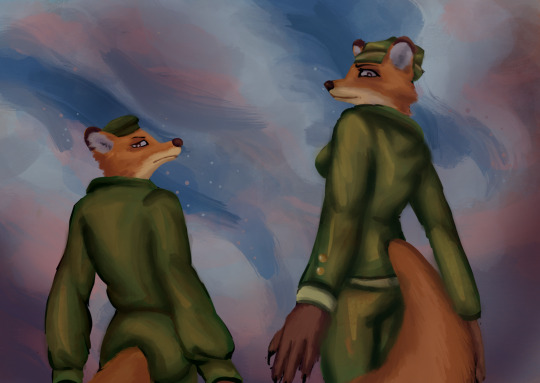
Oh yeah! We got the show female fox and the manwa male fox!
I tried to render this piece more. I think the clouds turned out better than the characters. The hard round MAX OPACITY brush really did wonders for my art. But it’s time to introduce softer gradients. I got to constantly innovate after all. I first drew the characters with the hard round MAX OPACITY brush. I found their uniforms a bit too monotone. So I added some red to them with a very textured brush. Not the best idea. You can still see some of it on the female fox’s butt. I would have removed it but… I merged the layers and I couldn’t reverse it. Whoops.
Life goes on. So I used the airbrush to smooth out the texture. It preserves the original brush strokes while making everything more united. I learned that from working on a piece inspired by Leonardo Da Vinci. I think the best turned out the male fox. For the female fox I used a little too much airbrush. Soft brushes are really hard to master.
I could ramble more about the art process. I think it’s something really important to document and share. But now I want to get to what I think of Lt. Vixen.
At first I was kind of annoyed at her popularity. Men being unable to see a female character and not sexualize her challenge. But then I watched the episodes she was in and I was like OH. As a pansexual I was HOOKED! Special shout out to her voice actress Lim Um-Young. The whole show is bizarrely horny for puritanical North Korean standards. Looking at you mice maids. If you want to learn more watch Paper Will’s video on North Korean entertainment. It’s great.
She is also definitely one of the best characters. A true girl boss. So sad they didn’t make any more episodes. So much lost potential.
Her male counterpart… I haven’t read the manwa because I know like three words in Korean. So all I can say is that I like his character design. Both of their character designs are great. I imagine he’s probably your general evil angry guy. The stories are generally focused more on plot than character. And that’s alright. All the more room for head cannons!
I don’t include the wolf army in my AU because they’re a little too modern for my taste. I like to keep things early 20th century vibe you know. Also by the time I got around to season 2 the first time I was already kind of burned out. But here are my ideas.
At first I thought Lt. Vixen could be trans. But I didn’t have much ideas on what to do from there. So I thought why can’t there be more than one fox? Specifically the manwa fox could be her twin brother!
The two of them grew up in a shitty orphanage. They were their only family and they HATED each other. I got to give them names. Vixen is the female fox and…I dunno Bob is the male fox. It’s just so you don’t get confused while reading. The hard life in the orphanage made Bob more empathetic and inward focused (he writes sad gay poetry trademark). Meanwhile Vixen lost all her empathy and her range of emotions is very shallow. I like the creepy idea that she just doesn’t have a soul poetically speaking. She bullied Bob their whole childhood. Bob feels weak and like he can’t do anything without his sister. Even though he views her as the embodiment of evil.
The only way they would become anything more than poor factory workers was by joining the military. Both of them earn their ranks by seducing their hireups. Even though Bob hates being in the military and would love to just go be sad and gay somewhere else, for the first time he feels like he can be something without his sister. When he starts to earn his ranks faster than Vixen she does not like it. And she murders him!
Oh my goodness! This post been going on for ages. I haven’t even gotten into my ideas for Lt. Vixen X Geumseagi and how Bob plays into it all! Send me another ask if you want to see that.
#Got a little carried away#was going to post the ask sooner but had to take a break#we need more fanart of the manwa fox#let’s just all agree that the manwa fox’s name is Bob alright?#my art#digital art#fanart#procreate#furry art#ask#squirrel and hedgehog
11 notes
·
View notes
Text
Things that I think would happen if Bucky dated an Egyptian!reader
Based on this request from @aesthetic0cherryblossom
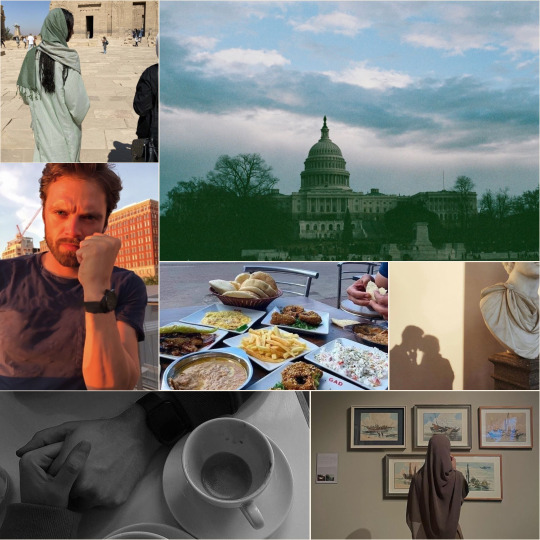
disclaimer: credits to original creator/poster of image/gif. found on google/Pinterest
1. Bucky has always been fascinated with Ancient Egypt
American Egyptomania is what they call the time of renewed interest in the culture of ancient Egypt that happened in America in the late 19th century and early 20th. Like I mentioned in my first Arab reader headcanon list, with Bucky being from Brooklyn it’s likely that he experienced more diversity than most. Also with how social he was, I genuinely believe that he would’ve experienced more than Steve. Anyways his exposure to ancient Egypt would have come from the many museums in New York that were a part of Egyptomania however his knowledge about “modern” Egypt would have stemmed from his interest in the first world war. Egypt had a significant but forgotten role in the war and with his dad dying during basic training, I can see him having a special interest in it and thus learning more about Egypt.
Now, fast forward to 2023 a form of self-care for Bucky would be going to museums and essentially re-learning everything that he spent years reading about as a kid. And we know that he was a reader because he read the Hobbit when it first came out in 1937. It didn’t become mainstream until almost 3 decades later in the 60s so that would lead me to believe that he read literally everything that he could.
Back on track now, these museum trips are a way for him to catch up, as well as feel connected to who he was before.
Since he is tied to D.C. thanks to his government mandated therapy, he goes to the Smithsonian more than any other ones. He loves the Eternal Life in Ancient Egypt exhibit more than anything, and he visits it all of the time.
Once again, this is where you come in. You two didn’t meet at the museum but instead literally ran into each other as he was leaving therapy. He was in a terrible mood and ran straight into you, spilling your coffee all over your white shirt. He felt awful and apologized profusely but you weren’t concerned.
“I don’t even like this shirt anyways,” you told him with a smile that made him swoon.
After that, he’d see you every week after his appointment and he slowly started to look forward to Dr. Raynor. She made a comment about it which he quickly shut her down saying that “maybe our sessions are helping or maybe I just want to get out of here.” She reminded him that she could extend his court mandated appointments if she thought it necessary.
Finally he worked up the courage to ask you out and offered to buy you a new shirt. You accepted and told him that lunch would be a better replacement. He let you pick the place and you took him to Fava Pot, the only good Egyptian restaurant aside from your kitchen.
The two of you talked for hours about everything and nothing at all. Slowly the topic of you being Egyptian came out and it took everything in him to not lose his shit. Before he could stop himself, he told you all about how he’d loved Ancient Egypt growing up and how he’d go to the Smithsonian almost weekly to look at the exhibits. At first you did say a word but then the giggles erupted for you, causing everyone to look at your table. You grabbed his arm and drug him out of the restaurant without a word about why and the poor guy was so confused.
You finally explained that you would give him a real tour and alas your weekly museum dates were born.
2. Your culture is hard for him to grasp at first.
Important note for this hc": there is a very old and heated debate about whether or not Egyptians are Arab. While I’m Arab, I’m not Egyptian and not at all qualified to even touch that debate. With that being said, the cultural differences were specifically requested so my hope is that this section comes across as neutral in regards to that debate. If it doesn’t or i get something wrong, please correct me. Everyone deserves accurate representation.
As I said in my first Arab!reader list, there is a lot of misinformation about the Middle East and North Africa which makes research very difficult. The above debate is a prime example of this. Bucky tries really hard to do as much research as he can on his own so that he can surprise (and impress) you but ultimately has to ask you. He takes it as a personal hit that he can’t do everything in his power to understand you better because you’ve done that for him. However you remind him that he’s an Avenger and literally has biographies written about him.
“Rouhi, no one is expecting you to be a walking encyclopedia. Let me help,” you said in a gentle tone one night when he was getting frustrated with whatever show he was watching.
“That defeats the purpose of me learning about your culture. I should be able to do it on my own,” he threw back from the couch where he’s laying with the cat that he definitely didn’t want on his chest.
“You can do a lot of other things on your own. You’re a big boy, you’re 107! This, however, is difficult for anyone and I’m more than willing to help.”
He glared at you for calling him that and for pointing at his age but his gaze softened when you dropped onto the ground next to him with a plate of food. After that, in addition to your Arabic lessons, the two of you play trivia so he can learn more. It’s really you quizzing him on flashcards and every one he gets right, he gets a kiss. The arrangement works out in both of your favors really.
3. The more serious your relationship gets, the more Egyptian traditions/norms he incorporates into your life.
This starts out with little things like taking his shoes off when he walks in. With time he’ll start adding more things like visiting your family as often as you can as a couple and bringing some sort of gift, usually sweets or the chocolates that your dad loves. During dinner, he’ll make sure to get a second plate and leave a small amount leftover. He’ll change how he compliments you by making an effort to compliment specific things like how your hair looks that day or how he likes when you wear black. He’ll also start showing gratitude when you compliment him by responding to a compliment on the same thing. For example, if you tell him how good he looks that day, he’ll tell you that you look radiant. If you’re Muslim, he’ll add “Allah Yen’im ‘alik” which is how you wish someone Allah’s blessings (from my understanding).
Eventually he acts more Egyptian than you when you’re with your family and your mom will not let you forget it. She’s always telling you that Bucky is such a good man and how he’d be the perfect son in law. Those conversations are usually followed by her asking when you’re going to get married and looking him dead in the eyes to make her point clear; hurry up and propose. Ever the charmer, he’s able to rely on that Brooklyn sweetheart that lives inside of him and move the conversation to something else. Of course, your mom knows what he’s doing but she’ll allow it because she can feel the proposal in her bones (and it never hurts to have that brilliant smile directed at you.)
#bucky barnes imagine#bucky barnes#bucky barnes x reader#bucky barnes x y/n#bucky barnes x you#bucky barnes fic#marvel imagine#egyptian#Egyptian reader#Bucky x Egyptian reader#bucky barnes fanfic#bucky barnes reader insert#marvel
26 notes
·
View notes
Text
I’ve been digesting the video essay Orientalism & the Gerudo over the past couple of days. The first half of the video is a basic, consolidated summary of arguments I’ve seen people make about SWANA representation and Black representation regarding the Gerudo that also includes more academic sources to try to explain to newcomers or people unfamiliar with the term “Orientalism” where these points came from. I’m hoping this opens up some discussions across the wider fandom.
My only criticism is that, sometimes, the points can meander a bit between each other without clear boundaries between which talking point is which, leading to occasional moments of “Huh? How did we get here?” or “Wait, what about that other point you just made?” However, I think that’s a symptom of there being just so much to talk about regarding the broader umbrella topic that this video is trying to cover that it’s hard to know when/how to fit stuff in. You could make a whole essay about only how Arab men are depicted as aggressively misogynistic threats menacing Arab women to justify modern imperialist invasions of the Middle East by Western powers and how that ties in to the way Nintendo refuses to show Ganon having a more humanized, complex relationship with his own people. Even after a whole hour it feels like we’ve only just scratched the surface.
However, I also don’t think this “meandering” is necessarily negative because it sometimes ended up leading to great points that I hadn’t considered before. For example, I was initially confused about why the essay started focusing on Rauru and the plot of TotK after the halfway point, but it ended up not just being a useful example of how Japan reproduces Western tropes from pop cultural influences for fans who weren’t quite convinced about the essay’s arguments in the first half because they assumed Japan was in a cultural vacuum where racism doesn’t exist, but also gave me a totally new perspective about Rauru’s character beyond my initial Shintoist reading of his role as a divine ancestor that legitimized the royal family’s rule.
Rauru and Mineru’s designs and backstory borrow visual and literary tropes from depictions of indigenous peoples in American media to legitimize him as “indigenous to Hyrule” and therefore an important founding figure in its revised origin myth, but these tropes reproduced without awareness of their original cultural context also serve to “unperson” him as a character within the story. He’s sequestered into a distant past where he can’t really interact with characters in the present, not even truly “owning” the kingdom he founded, which instead passes to the Hylians, who coopted his legacy of unification for their own ends but completely forgot about him. He and his sister are treated more like “resources” for Link/the player to take advantage of to achieve their goals than characters in their own right. And, emotionally, the Zonai siblings are so distanced from the main cast and each other by being treated more like concepts of “nativeness” than people in their own right that their own descendant feels like a stranger visiting an exotic land instead of long-lost family reconnecting with her roots.
Like…it’s a really clever way to introduce two equally complex points that people should keep in mind when examining the Gerudo. First, that you can’t really treat Japan’s depictions as the exact same as Western depictions, because while Japan isn’t “the West,” it has its own complicated history with racism and imperialism born out of the “pan-Asian” nationalism of the early 20th century. At the same time, Japan doesn’t exist in a hermetically sealed cultural vacuum totally isolated from Western influences that makes Japanese creators incapable of learning about cultural nuances regarding racism, despite what fashy weebs personally invested in the myth of Japan being a magical exotic fairyland where “woke” doesn’t exist want you to believe.
I hope this video essay inspires other people to look into this topic further and maybe contribute their own works to the discussion.
18 notes
·
View notes
Text
There is so much characterization tucked into "The Statement of the Case" in the 2nd of Letters from Watson about The Sign of the Four. To marshal my thoughts at all, let's go by character, starting with my cinnamon roll Dr. Watson, then turning to Holmes and to Mary Morstan.
Watson
Watson's close observation of Miss Morstan demonstrates that he's capable of making deductions from observation. He deduces from the simplicity of her attire that she has limited means, and he has a good deal to say about how the character promised by her features and manner.
In an experience of women which extends over many nations and three separate continents, I have never looked upon a face which gave a clearer promise of a refined and sensitive nature.
This is a tiny bit amusing because all of Miss Morstan's actions suggest she has the orderly soul of someone who would have been an accountant in an era more supportive of women's careers. This woman keeps receipts. She may be nervous about bringing her concerns to the Great Detective, but she's not the slightest bit delicate.
Watson seems a bit pricked in the ego by Holmes' extensive knowledge of cigar ash, as he's touting his experience with women. That would be a monograph, indeed, something sold discreetly, in a corner of the bookshop behind a curtain. I'm going to guess that the third continent, after Europe and Asia, is Africa, both because the British did a good deal of colonial meddling there and because it makes Holmes suggestion of The Martyrdom of Man so much more apposite.
Holmes
The Martyrdom of Man turns out to be a progressive best seller about world history. Author Winwood Reade's perspective is to show the importance of Africa in the development of the world. This is entirely at odds with Victorian self-confidence about the white European and American missions of colonialism. Holmes is implying, deliberately or not, that Watson knows less about at least two continents than he thinks he does.
Reade's prose feels comparatively modern -- it has the sprightly feel of early 20th century writing rather than the long, turgid sentences of the 19th century. I've been distracted by reading bits of it, as while it's not how an historian would handle its topics today, it's an interesting read.
A side note on Winwood Reade is that he was open about being an atheist, so his book is also at odds with the popular idea of Divine Providence smiling about the endeavors of the British Empire. Contemporary audiences would surely have drawn some conclusions about Holmes' religious and political leanings.
The book recommendation is preceded by Holmes establishing that he's not a sentimentalist:
He smiled gently. “It is of the first importance,” he said, “not to allow your judgment to be biased by personal qualities. A client is to me a mere unit,—a factor in a problem. The emotional qualities are antagonistic to clear reasoning. I assure you that the most winning woman I ever knew was hanged for poisoning three little children for their insurance-money, and the most repellant man of my acquaintance is a philanthropist who has spent nearly a quarter of a million upon the London poor.”
My first reaction was "welp, he really is ace, isn't he?" On reflection, I think that reaction is both right and wrong. On the side of "right," there is no way that Holmes, as written, is a neurotypical allosexual heterosexual. Asexuality is not the only possible category for him, but it's a solid contender.
On the side of "wrong," what he's arguing for from "I assure you" on is simply not to judge a book by its cover. We're used to that as a moral. We're also accustomed to believing that "body language" and such can give clues to the person within. Heck, Holmes was just on about handwriting analysis. So there's a messy little tension here between two views that were common then as now: "outer aspects reveal the person's true nature" and "don't judge a book by its cover."
Mary Morstan
I like Mary Morstan a good deal, not least because she keeps receipts.
This image from the New York Public Library gives a sense of Mary's plain beige walking suit, though the feathers are far too big.

My first reaction to Mary Morstan's backstory was to check the publication date of Frances Hodgson Burnett's A Little Princess, because how many little girls were being left in boarding schools by their UK Army officer fathers who were serving in India?
Quite a few, it seems. It was standard practice to send children back to the UK to boarding school "for their health." That last euphemism raised my "what in the racist colonial claptrap" hackles, but there was a legit health concern -- malaria. Malaria is potentially deadly for anyone and worse for children, since a child who survived might have ruined health and intellectual development for life. It was not until 1897 that surgeon Ronald Ross established that malaria was transmitted by mosquitos. Miss Morstan was a child in India in the 1860s; she really would have been sent away for her own safety.
Meanwhile, although A Little Princess was published in 1905, it was expanded from a short story published in 1887. a few years before The Sign of the Four was written. That doesn't mean there's a connection: stories about a common situation and the fears arising from it are going to have similarities.
Miss Morstan's lack of English relatives did have me wondering if her mother was Indian, especially as her complexion lacks "beauty" (isn't translucently pale). Since she's blonde and light-eyed, presumably we're to assume that both parents were English or Scottish. (The genetics of eye color inheritance weren't established at all until 1907, but people obviously had folk beliefs about how much children looked like their parents, and in what ways, before that. Using today's knowledge, it seems possible that her mother had one English parent and one Indian parent, but who knows?).
At twenty-seven, she is "on the shelf" -- past the ordinary age of courtship and marriage. Her job as either a companion or a governess implies she brings no financial assets to a marriage beyond those mysterious pearls. Watson's musings that twenty-seven is "a sweet age" establishes both that he's head-over-heels for Miss Morstan and that he's enough a man of the world to prefer a woman "a little sobered by experience" to a blushing debutante.
So do the mysterious pearls mean we're going down a path superficially similar to Wilkie Collins' The Moonstone (1868), where a heroine inherits a mysterious gem from a British Army office relative? Rachel Verinder's uncle was a horrible person who came by his gem in the worst way; but Mary Morstan's father was a guard at a prison for political prisoners, which doesn't bode well for his connections. Mary has far too much good sense than to wear her pearls, though.
I do want my cinnamon roll Dr. Watson to get the girl.
16 notes
·
View notes
Text
Interview with the Vampire: We Need to talk about the design of the so Called Rock Garden (Contains Spoilers through the Finale)
Something that my brain has been pick, pick, picking at since first season of Interview with the Vampire is that Rock garden in Dubai. I've been watching season two as it came out, but also rewatching it with a friend who otherwise hasn't access. Last week we stopped watching while they were making the deal to sell that artwork to discuss the decoration of the Dubai apartment because they had been pick, pick, picking at the interior design in general this whole time too. I'm not Japanese, so grain of salt here.
So a lot of people have discussed the way the bedroom looks like a prison with the bars and lighting, but it runs so much deeper and darker than that. We got talking about Louis' taste in art and design, much the way my friend and I hot into Louis and Lestat and fashion choices first season.
Okay, look at the whole apartment. Sure it's just generally in that soft brutalist minimalist design the rich are all into right now, and Armand who may or not be lying says they had an interior decorator, but that apartment set is not designed like some generic designer furnished it. It is designed like someone or someones told them what they needed, but also what they liked. You can see Louis in Paris' mid 20th century eye in things like the Bacon and the sort of furniture you see in the dining room and that sort of living room area. He was doing the American in Paris after the war bohemian thing and there was a movement connected to university culture and beatnik culture in America and American ex-pats from the 40's through… some point in early sixties with a particular type of interest in East Asian culture and certain types of African art. That's going be important in a moment. You can see little touches in all that 21st Century rich person soft brutalism and think it's all guided by the taste of the occupants, who want to look very up to date, but whose tastes and interests were formed in another time. It's really obvious in the bedroom, but it's everywhere subtly once you start looking for it. (Props to the set dressers who were on point).
Let's stop and think about Armand, for a moment. Armand who doesn't know who he is, both in the literal chunks of past are missing and in the psychological sense of he's spent five hundred years trying to mold himself to whatever he thinks other people want or need him to be, hiding his own desires and motivations from himself. He knows he wants/needs someone or something to mold him and he will literally do anything to get that, including burning down the last thing in such a way that he can tell himself he didn't really do it. Circumstances or someone else did it or made him do it. He is utterly ruthless in that pursuit. What he wears, how he presents himself is designed to appeal to the taste and expectations of who/what he's molding himself to. The Amedeo outfit for Marius. The dingy barely dressed outfit of his Satanist coven Gremlin era. The far more respectable outfit he wears the night in the balcony when he declares love for Lestat. The Post war European hipster outfit he wears while seducing Louis, dressing in hopes of being appealing in the way Paris' Bohemian side is to Louis who is dressed like an American college student abroad to study at the Sorbonne. The season two Dubai outfits, perfectly chosen to look modern and elegant but not too formal. Louis always dressed Lestat in modern fashions and Louis modern Louis dresses in a similar, but slightly less formal style…. Armand is dressed for louis. (Props to the costume designers who were on point. I love how in first season you can absolutely tell if Louis or Lestat picked Lestat's outfit in a scene, something we had a lot of fun with. We had a roaring time with season 2 choices as well).
So which things in the apartment are Louis and which are super subtle Armand touches?
Which brings us to the rock garden. Maybe the designer did suggest it as because the need for nature as Armand suggests in season one, but that's not what it's doing, is it? Nor is it functioning as the kind of meditation space they are trying to appropriate. Look at the real meditation gardens. Outside. Lots of live growing things. Boulders suggesting islands and/or mountains. Raked soft sand to suggest water or wind. The whole design is intended to aid meditation, right?
Now look at the travesty in the Dubai apartment. It's a prison cell. A beautifully made, super expensive prison cell, but the stark white brutalist walls and hard angles. Light from above like light through a grate into a prisoner's cell in a ninetieth century novel about the olden days. One sad tree instead of a whole surrounding garden. It's a cell or a prison yard, it's not a meditation space.
Books are kept high up with no ladders where only vampires can access them and Armand cut pages away supposedly for Louis' own good, though not really. Literally and symbolically both it's the opposite of a public library with easily accessible knowledge anyone can have. Armand entirely controls and drip drips whatever narrative he wants to share
Now lets get back to the sand in the meditation area, shall we? Is it soft white sand? No. It's rocks. Small rocks. That can't be comfortable right? So before I even saw the finale, I was saying: I can see a caring partner of a depressed person who can't go outside in the day making an indoor meditation garden to help them, but this isn't that garden. This is a stark and depressing prison cell designed to look like caring but actually sabotaging healing. I can't imagine digging my toes into gravel to meditate (Characters periodically do that: burrow there feet into the pale white gravel), it's distracting.
Then the Finale dropped and I'm sure of it. That is literally the type of gravel they buried Louis in. O.o Louis still has the same gravel inside his feet and ankles, his skin having grown over them during the most traumatic period of his life. he was mourning Claudia and starving and being driven mad by the most extreme form of solitary confinement I can think of. Every step must still be a torment to him, like the little mermaid's sensation of walking on knives. Every step Louis takes reminds him of the loss of his daughter/sister. Talk about penance. O.o So knowing this, either Armand or Louis had the designer fill the false meditation room with a torture device and got the designer to trick it out like a cell.
Seriously, I can't work out which is more fucked up: Armand doing it to keep Louis sick and fragile and too depressed to leave or Louis doing it to himself as a form of self harm. Either way it's seriously fucked up.
Can someone get these three Vampires (Louis, Lestat, and Armand) a real psychiatrist and not just a reasonably self aware journalist who has made a wreck of his life? Let's through in some professional help for Daniel too while we are at it.
Seriously, I am this close to going absolutely feral over this show the way I did for Black Sails and for the same fucking reason.
13 notes
·
View notes
Text
Peerages & Titles: general info
[Full list of disclaimers is in the master post but tl;dr is that sources for this information are not consistent, sources may be modern, and this may be edited/expanded at anytime as my research continues.]
Let’s go! This is the general/summary info I think you should know when writing peerages, and I think is a good starting post before the deep dives. [All can be found in the master post].
All peerage holders are considered peers of the Realm.
Anyone can have multiple and seemingly unlimited peerages [be Viscount of one thing, Earl of another and Duke of another etc] but they will always be addressed as their highest title.
A Baron is never The Baron Featherington, as the higher titles are styled.
The wife of Baron is not [or very rarely, it’s complicated] referred to as Baroness. A Baroness is a woman who holds a Barony in her own right. Portia Featherington is not a Baroness.
Of is used when the peerage of a Marquess or Earl is based on a place, not a family name. For example; if Danbury was a place, then Agatha would be The Countess of Danbury. It is not a place so no of is used.
Duke’s always use of regardless of if it’s based on a place or surname.
Whilst Baron, Viscount and Earl may be based on a place or family name, they are more commonly based on a place/territory [despite most of the Bridgerton examples being based on family names] however the of is not typically used for Barons or Viscounts.
I believe it might be technically possible for a Marquessate or Dukedom to be based on a family name, but I’ve not seen any examples of this and it’s based on a place like 99% of the time if not always.
Some sources say a Marchioness may be called Marquise, however this is the French title, and some sources regarding titles in the UK are very against it.
Dukes and Duchesses are not addressed with their name, hence why it’s not in the table.
All formal letters sent to a peer should be signed Yours faithfully and all social/informal letters should be signed Yours sincerely
First names were rarely used, even by close relations and in intimate settings, until the early–mid 20th century in England. They were often limited to children growing up together and boys/men at school.
Parents may ignore children’s titles when addressing their children, but very often a mother would use one if it was available—such as a son’s courtesy title.
Men could show intimacy through using a close friend's name without the title; for example, just using Bridgerton or Hastings.
Spouses often remained formal, even in private, and would commonly use My Lord/Lady or sometimes pet names such My Dear or My Love. However, this depended on the couple and their intimacy.
Link to the master post with all the forms of address here. Drop any questions in my ask :)
–GW xo
#writing#fanfic#writers of tumblr#fanfic writers#Bridgerton#bridgerton fanfiction#bridgerton fic#downton abbey#downton abbey fanfiction#qcabs#qcabs fanfiction#writing help#writing tips#historical fiction#fanfic help#titling rules#titles#how to write English peers#peerages & titles#honorifics#forms of address#ask me about my hyperfocus
8 notes
·
View notes